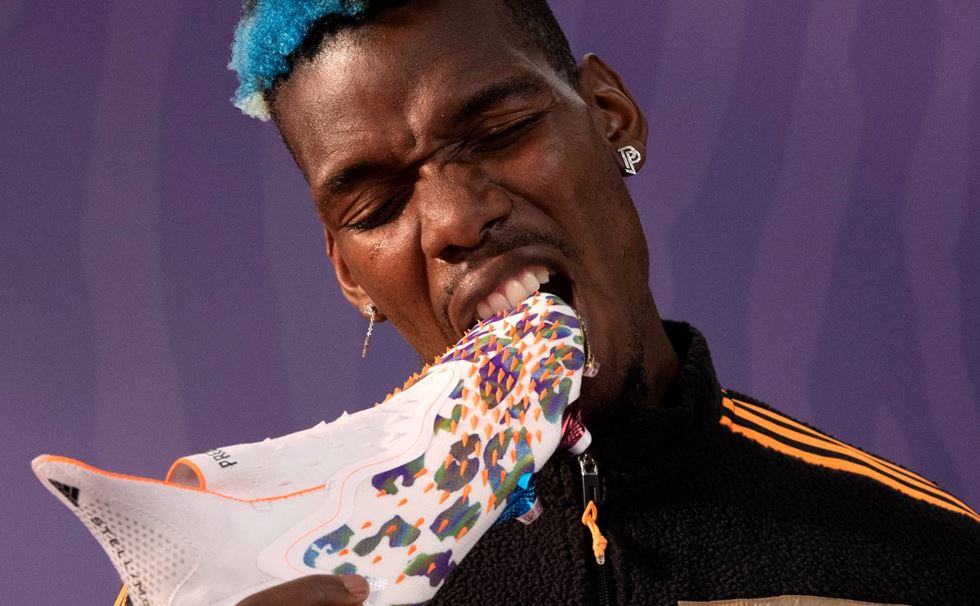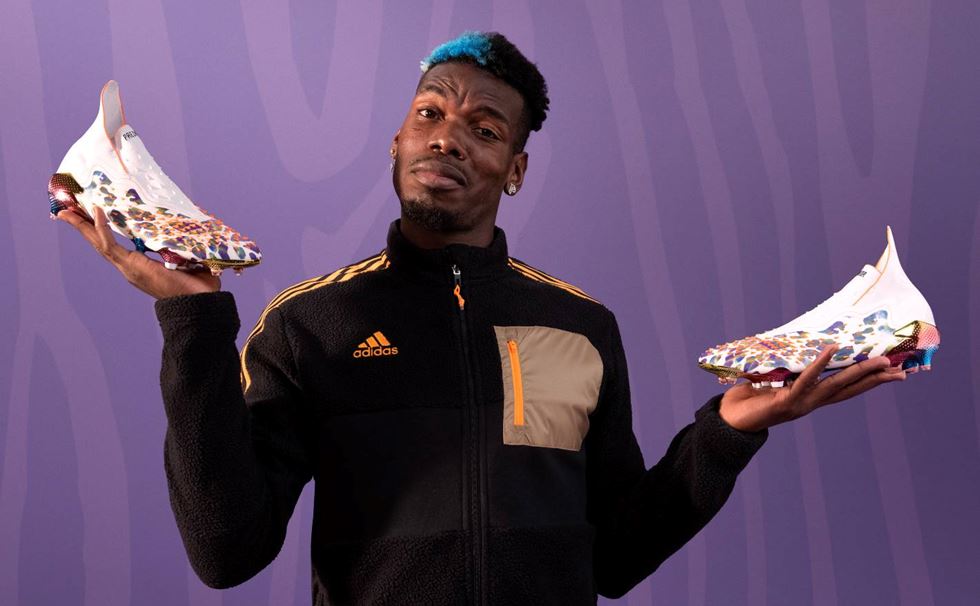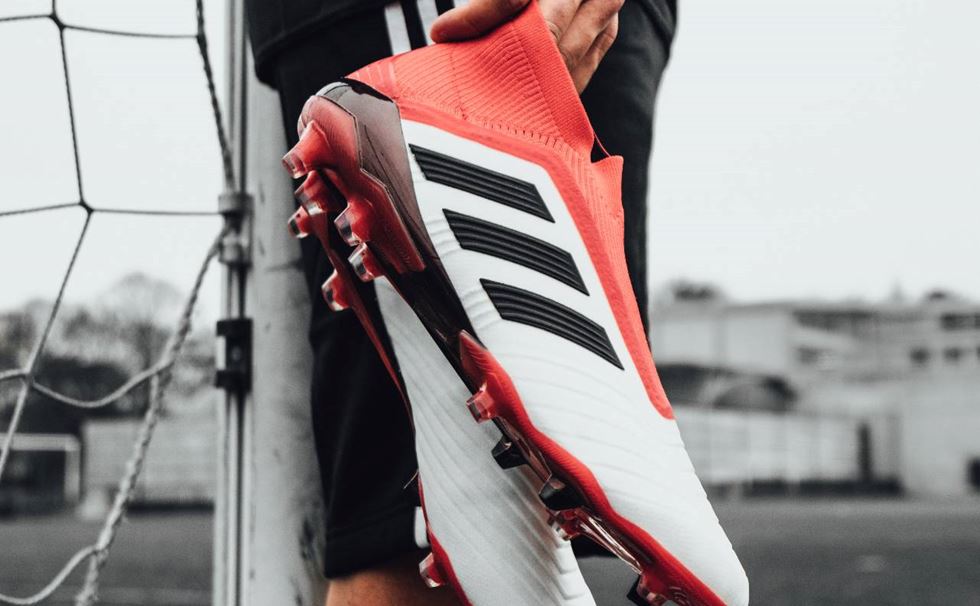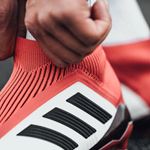Interview Football: Designing the Beautiful Game
Sam Handy: The Revolution Will Be Rubberised
When adidas launched the first Predator boot in 1994, the world of football had seen nothing like it. This was an earthquake in a market that had stuck to what it knew for so long, and the brand knows that it must build on this with each new iteration of the boot.
Sam Handy, Vice President of Design at Adidas Football, tells us what it’s like to work on a bona fide design revolution ...

Predator boot, 1994, The Adidas Archive/Studio Waldeck
The first boot to really change what people thought a football boot could do, from both a playing and a manufacturing perspective, was the adidas Copa Mundial. The screw-in studs that Adi Dassler created to use in different weather conditions were revolutionary. The next big innovation was Predator.
I work with a lot of professional footballers, and it’s very difficult to get them to change their boot. They’re essentially never looking for the next big thing in boots because they’re so superstitious, and if they’ve got something they feel comfortable in and it’s working for them, they’re very hesitant to change it.
So, it’s the role of a performance innovation brand like adidas to investigate and find a way that their game can be improved. They’ll only ever change if we make something that genuinely improves their game, and that difference is made in the sports science research and the materials research.
'It’s the role of a performance innovation brand like adidas to investigate and find a way that their game can be improved'.

Paul Pogba x Stella McCartney; Predator Freak, Adidas

Paul Pogba x Stella McCartney; Predator Freak, Adidas

Paul Pogba x Stella McCartney; Predator Freak, Adidas

Paul Pogba x Stella McCartney; Predator Freak, Adidas




David Beckham once told a story about the first time he saw someone playing in a Predator, and how he remembered thinking ‘I’ve got to get myself a pair of those. Let me try them on.’ Once you see a pro or peer playing in something that’s clearly giving them an edge, a stone drops and you see a ripple effect.
From a player perspective, if you’ve ever kicked a football, you know that getting more grip at contact will help you control it better.
When adidas took the Predator off the market in 2015, it was because the boot had become too similar to its competitors. And so, when I started working in football, it was a football with no Predator. I missed it as soon as I started.
We were kicking off things for the World Cup in 2018, and I remember saying, ‘Surely we need to use the platform of the next World Cup to bring back the best franchise in football.’ As much as there were people who loved the idea, there were lots of others who said, ‘No, we need to move on, you can’t go backwards.’ My argument was that when you have an iconic product like a Predator, it’s timeless, and if you build the best-performance Predator you’ve ever done, then the name Predator doesn’t make it old.
'The design innovation was something that was easy to understand: this product lets me grip the ball better in the place where I kick the ball. It’s a really simple, linear, easy-to-comprehend design. '
David Beckham describing the Predator boot
So we created the new boot, the Predator 18, with things like a brand-new knit forefront and a ribbed control zone at the front that was part of the boot and not made of rubber. The first thing everyone does with a new boot is the ‘thumb test’, and I think that boot with the ribs had a really special material on top of the prime.

Predator 18, Adidas

Predator 18, Adidas

Predator 18, Adidas

Predator 18, Adidas




I’ll use Paul Pogba as an example. In 2016, we did a Juergen Teller photoshoot with Paul ahead of the Euros, and I was in his house. For Juergen, Paul pulled out his boot collection and in it were all of these iconic, mid-nineties Predator colourways.
It was very powerful, and made me think ‘OK, you’re a young, elite professional footballer at the very top of the game, and you’ve just pulled out your own Predator collection.’ I knew at that point that the relaunch would be a slam dunk. And it turned out to be the case that whenever we showed that new Predator to professional players, you’d just see people’s eyes change. And now that we’re working on the new iterations, it’s a similar thing. It’s a shoe that gives people sparkly eyes, somehow.
'These boots are a very ageless concept. There are as many people in their forties and fifties who are in love with the Predator as there are people in their twenties and younger'.

Page from Adidas Trade catalogue 1994/95, Predator campaign, The Adidas Archive,
We’re now at the stage where the relaunches are being revolutionised, and if you hold the evolution of the new shoes in your hand, Predator 18 through to 20, you see a linear change where they are becoming better performance products. We brought in the prime knit and the rubber back, something people felt was missing from the first relaunch, with the 406 individual rubber Demon Spikes for that grip. It’s difficult to work on an icon, where people are saying the original is the best, don’t touch it, don’t relocate, but it’s more ‘I don’t want to break it, I just want to evolve it.’
That happened recently, in late 2021, with the vegan Predator that Paul Pogba made in collaboration with Stella McCartney. Never would I have expected, all those years ago, that adidas would make the first vegan shoe, and that it would be praised. Typically, you’d think it’s the brutal, tough, aggressive boot, and lo and behold, it’s the world’s first vegan football shoe. It’s surprising, interesting, perhaps even something that looks counterintuitive, and very cool.
And that, for me, is how it started. A classic football boot with everything better from the future added to it.
Written by Sam Handy. Originally published in ‘Football: Designing the Beautiful Game’ exhibition catalogue.
Buy the book
#DesigningFootball Stories
The exhibition catalogue features contributions from figures across the world of football and design, from analyst Statman Dave and broadcaster Martin Tyler, to architect Jacques Herzog and VP of design at adidas Sam Handy. The diverse perspectives reveal the extraordinary richness of the game’s design legacy and cast new light on its future. Buy online or pick up your copy at the exhibition shop. Click and collect at the museum or home delivery options are available on the Design Museum Shop website.
Discover the beautiful game
10 Unmissable Highlights from #DesigningFootball
From original kits to a match ball that decided on a match score – check the top 10 items from our exhibition.
Podcast: Gary Lineker in conversation with Tim Marlow
Hear Gary Lineker talk about some of the highlights in his career, and reflect on why football holds such an important position within our collective consciousness.
The exhibition